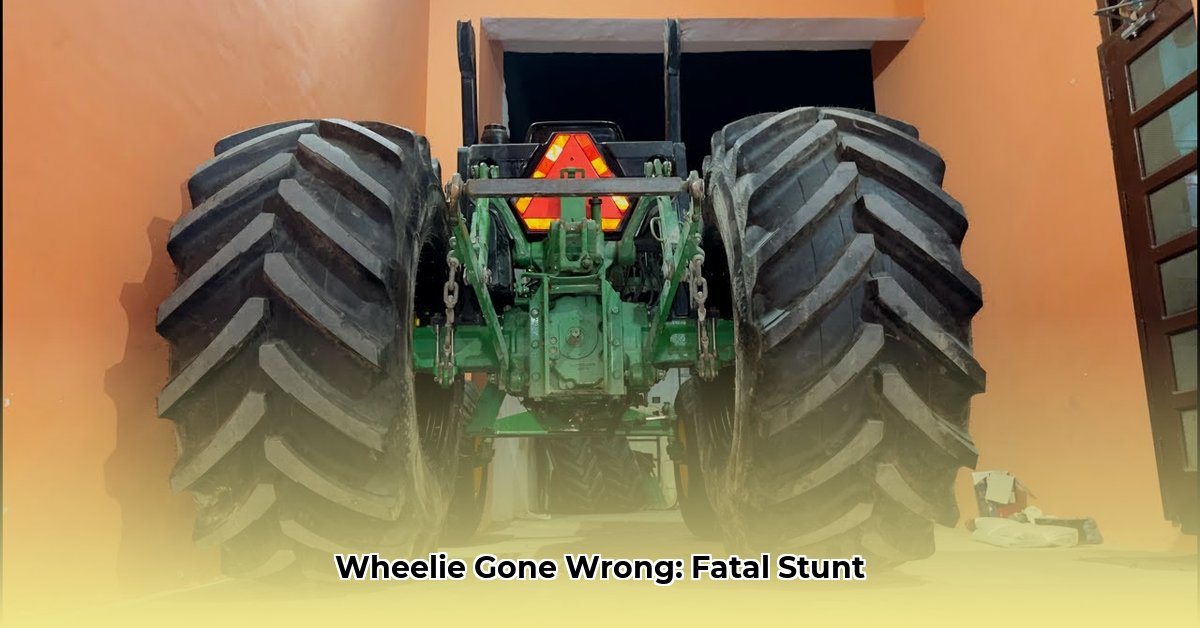
The Viral Video and its Devastating Aftermath
The recent death of Nishu Deshwal, a popular Indian agricultural YouTuber known for his daring tractor stunts, has sent shockwaves through the online community and highlighted critical safety concerns within the agricultural social media landscape. Deshwal's tragic accident, captured on video, depicts a high-speed wheelie gone wrong, resulting in fatal injuries. His millions of followers are left mourning the loss of a vibrant personality, while the incident serves as a stark reminder of the dangers inherent in combining agricultural machinery with online performance. The once-celebrated Nishu tractor now stands as a somber symbol of his untimely demise. This incident raises questions about liability, regulation, and the responsibility of content creators, manufacturers, and social media platforms. For more information on similar accidents, see this recent report.
Analyzing the Contributing Factors
Several factors likely contributed to this tragedy. While a comprehensive investigation is pending, initial observations point towards several key areas:
Tractor Modifications: A Potential Safety Compromise?
Reports indicate that Deshwal's tractor may have undergone modifications, potentially compromising its structural integrity and safety features. These alterations, while possibly intended to enhance the visual impact of his stunts, might have increased the risk of accidents. The stability and structural capacity of the tractor, especially during maneuvers like high-speed wheelies, are crucial safety considerations. Were these modifications sufficient to handle the extreme forces involved? Further investigation is needed to establish a definitive link between the modifications and the accident.
Regulatory Gaps: The Missing Safety Net
The absence of specific safety regulations governing online stunts involving agricultural machinery exposes a significant regulatory gap. Currently, there are no established guidelines or oversight mechanisms to protect content creators or mitigate the risks associated with such activities. This lack of regulation creates a dangerous environment, where potentially lethal stunts are performed without adequate safeguards. The incident underscores the critical need for policy changes to address this oversight.
Legal and Ethical Implications
The Nishu Deshwal tragedy presents a complex web of legal and ethical questions. Several entities may bear some degree of responsibility:
Tractor Manufacturers: Manufacturers could face scrutiny regarding the design, safety features, and instructions provided with their equipment. Could the tractor's design have contributed to the accident, even considering the modifications? This warrants a thorough investigation into product liability.
Social Media Platforms: The role of social media platforms in hosting and promoting such videos deserves critical examination. Should platforms bear some responsibility for failing to adequately moderate content that depicts inherently risky behavior? The ethical implications for these platforms are substantial.
The Influencer: Finally, the influencer's personal responsibility cannot be overlooked. While the desire for online popularity is understandable, taking such extreme risks without proper safety measures is clearly unacceptable. This demands a broader discussion on the individual responsibility of content creators to prioritize safety over views.
A Collaborative Approach: Moving Forward
The Nishu Deshwal incident demands immediate and comprehensive action. To prevent future tragedies, a collective effort is crucial, involving all stakeholders:
Strengthening Safety Regulations: Governments and regulatory bodies must urgently establish clear guidelines and regulations tailored to the specific risks posed by online stunts involving agricultural machinery. These regulations might encompass licensing requirements, mandatory safety training, and stricter content moderation policies.
Manufacturer Responsibility: Tractor manufacturers should prioritize safety in their design and production processes. This includes improved safety features, clearer instructions, and campaigns promoting responsible equipment usage. Additionally, regular safety audits and robust product liability insurance are essential.
Platform Accountability: Social media platforms must invest in more advanced content moderation systems to identify and remove videos portraying dangerous behavior. Increased collaboration with safety experts and agricultural organizations could help develop more comprehensive safety guidelines.
Influencer Accountability: Agricultural YouTubers have a moral obligation to prioritize safety. Before attempting risky stunts, thorough risk assessments, safety precautions, and clear disclaimers about the inherent dangers are essential. Insurance and collaboration with safety professionals could mitigate risk.
This tragedy serves as a stark reminder of the need for a holistic approach to safety within the agricultural social media world. By addressing the regulatory gaps, fostering greater responsibility amongst manufacturers and influencers, and strengthening content moderation, we can work towards mitigating the risks and preventing future incidents. Nishu Deshwal’s death should not be in vain; it should serve as a catalyst for meaningful change.